From the Twelve
Fruits With Potential Value-Added and Culinary Uses
by Ken Love, Richard Bowen and Kent Fleming
Poha (Cape Gooseberry)
Scientific
name: Physalia peruviana L.
Family: Solanaceae
Origin: Peru
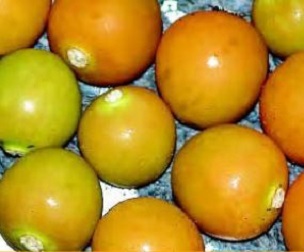
Cape gooseberry, called poha in Hawai‘i, was distributed by early explorers and first reported in England in 1774.
A commercial crop in many countries, the poha is often used in Hawaiian Regional Cuisine.
First noted on the Big Island in 1825, the fruit is common in the wild
and cultivated for home and commercial use around the state.
The
plant is a low-growing shrub with velvety leaves and yellow,
bell-shaped flowers. Mature fruit is round and orange skinned with many
edible seeds. It is juicy and sweet with a distinctive flavor.
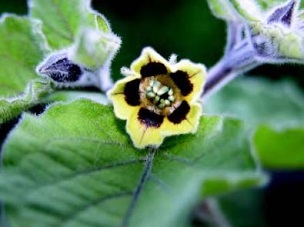
Poha flower
Cultivars
Poha
is also known as golden berry in many English
speaking countries. In Australia, it is marketed under the cultivar names
‘Golden
Nugget’ and ‘New Sugar Giant’.
Growers in New Zealand often take cuttings from plants that produce the
sweetest fruit for propagation.
Environment
Poha
is commonly found at upper elevations on mountain slopes from
1000 to 4000 feet and is reported to occur as
high as 8000 feet. Plants at lower elevations usually
produce smaller fruit. Because it is non-native in Hawai‘i and birds
distribute its seeds, poha is regarded as an invasive species, although
its threat to native species and ecosystems is not well characterized.
The plant’s shallow root system is best adapted to soils with
good drainage. The plant is among the first to take root in newly
cleared lands and does well in relatively poor soils. Fertile soils
favor vegetative growth over fruit production. Poha becomes dormant during extended periods of drought
unless irrigated. Harvesting is faciltated when plants are spaced 4–6
feet apart in rows and, optimally, trellised or staked. Planting in
raised beds has helped ease the labor of harvesting.
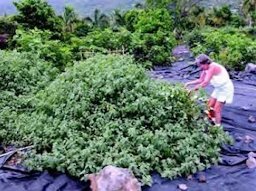
Harvesting poha at the 12-Trees Project orchard
Horticulture
Poha
tolerates a wide variety of soils with pH between 5.0 and 6.5. Because
of its shallow root system, similar to that of tomato, mulch and
organic soil amendments help retain water and nutrients.
Plants at the 12 Trees Project were given 1⁄4 cup of 6-6-6 organic
fertilizer every 4 months, placed around the drip line. Fruit ripening
can take several months, and harvest generally occurs 60–100 days after
flowering. Poha should be severely pruned after harvest, and plants
should be replaced after 3–4 years when fruit size and yield diminish.
Pests and diseases
The broad mite, Polyphagotarsonemus latus,
feeds by puncturing the stem and sucking the sap from the wound.
This will stunt growth, discolor leaves, and
deform young foliage. The solanaceous treehopper (Antianthe expansa), thrips, and various beetles can also affect the plant. Sooty mold (Asteridiella acervata), root-knot nematode (Meloidogyne sp.), and bacterial wilt (Pseudomonas solanacearum)
are among the pathogens that can affect poha. In general, good field
sanitation, appropriate horticultural practices, and an integrated
pest management program can prevent crop damage
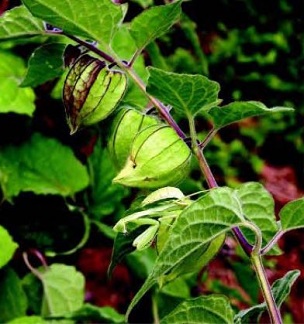
Papery fruit sacks (and a praying mantis)
Propagation
Poha
is usually started from seed but can be started from stem cuttings 6–8
inches long. A rooting hormone will help induce rooting. Young
seedlings are susceptible to high temperatures, and it is advisable to
plant them in the late afternoon or during cloudy weather. Seedlings
should be kept moist and shaded.
Harvesting and yield
Poha
is harvested every few days, when the husks are dry and
turn to a straw color. It is often picked in the afternoon, when
there is little moisture. Many growers shake the bush so that the dry
husks fall and are easily picked up from the ground. Plastic sheets are
sometimes placed under the plants to catch the fallen fruit.
Plants
at lower elevations (300–700 feet) under irrigation produce small
fruit in large quantities, sometimes more than 1000 fruits per plant.
Higher elevations (700– 3000 feet) without irrigation produce an
average of 300 large fruits per shrub. Averages in South America are 3000
pounds of fruit per acre. Laborers harvest 10–12 pounds of in-husk
fruit per hour.
Postharvest quality
Poha
will last up to several months dry and in-husk. Large commercial
producers store them in-husk at 33°F. They will keep more than a year
when husked and frozen. The husks are kept on when shipping the fruit,
and it should be stored dry.
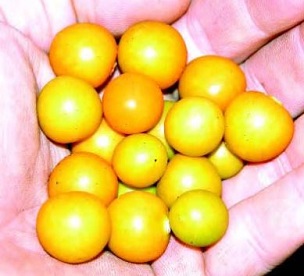
Husked poha fruits
Packaging, pricing, and marketing
In
Hawai‘i, poha fruit is often sold husked in local groceries and
farmers’ markets. In Japan, the fruit, grown in South America, is sold
in-husk in small blister packs. In Hawai‘i, poha can wholesale to
restaurants for as much as $3.50 in-husk and $7.00 husked, but it is
often found cheaper in grocery stores. Jam manufacturers and
restaurants throughout Hawai‘i continuously seek fresh and fresh-frozen
husked poha.
Food uses and nutrition
Poha
is often eaten fresh and made into jelly and jam or canned whole for
culinary purposes. In Europe, the fresh fruit is dipped into chocolate
or used to decorate cakes. It is also used in sauces. Poha is a source
of phosphorus, which helps the body process vitamins and aids in the
conversion of food to energy. The primary benefit of phosphorus is the
building of bones and teeth, when balanced with calcium and magnesium.
Poha also contains a cross-section of bioflavonoids (vitamin P), which
help with anti-inflammation and act as natural blood thinners.
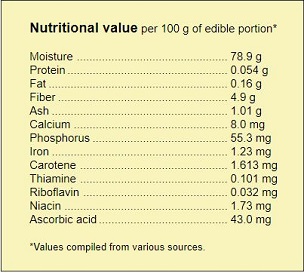
Poha apple vinaigrette
Chef Sandy Barr
2 green apples
1 cup poha
1⁄2 tsp sage
11⁄2 tsp tarragon
1 tsp salt
1 tsp chopped garlic
3 T sugar
1⁄2 cup white wine vinegar
3⁄4 cup vegetable oil
Peel, seed, and quarter apples. Microwave for 5 minutes.
Place
all ingredients except poha and oil in a food processor. Puree well and
then, with processor running, slowly add the oil. Add berries last, and
process until they are just broken.
Yield: 3 cups. |
|
Poha loquat salsa
Vince Mott and Ann Rothstein
Hawaii Community College - West Hawai'i Culinary Arts Program 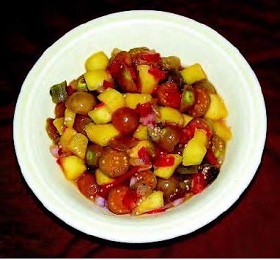
3 lb poha, cut in half
1 lb loquat, peeled and seeded
3 small mangoes, diced
1⁄4 cup red onion, minced
1 red bell pepper, minced
3 Anaheim chilies, roasted and diced
1 Kona Rangpur lime, juiced
3 slices fresh ginger
Zest of 1 tangerine
2 cups sake
6 cups water
1 T lilikoi puree
1 T olive oil
1 pinch salt
Optional: 1⁄4 cup cilantro
Cook
peeled loquats in simple syrup (1 cup water and 1 cup sugar), then cut
and dice. Save syrup to flavor salsa, if desired. Mix loquat with other
cut fruit and other ingredients. Add additional lime juice to taste. |
|
About
the Twelve Fruits
With Potential Value-Added and Culinary Uses Project
Back to
Cape Gooseberry Page
|
© 2007, University of Hawai'i
|
Bibliography
Love, Ken, et al. "Twelve Fruits With Potential Value-Added and Culinary Uses." University of Hawai'i at Mānoa, College of Tropical Agriculture and Human Resources, 2007, HawaiiFruit.net, www.hawaiifruit.net/12trees.html. Accessed 10 Sept. 2019.
Photographs
Love, Ken. Twelve Fruits With Potential Value-Added and Culinary Uses, University of Hawai'i at Mānoa, College of Tropical Agriculture and Human Resources, 2007, HawaiiFruit.net, www.hawaiifruit.net/12trees.html. Accessed 10 Sept. 2019.
Published 10 Sept. 2019 LR |






